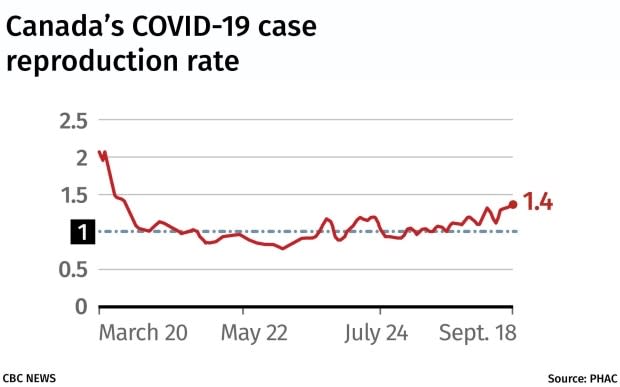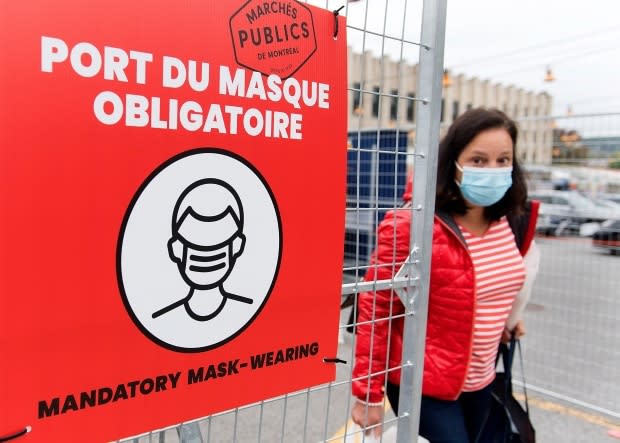COVID-19 in Canada will get worse before it gets better, and here's why

Cases of COVID-19 will likely continue to climb in Canada's most populous provinces for a while even if people start to hunker down, experts say, because of the nature of the infection.
Epidemiologists look at the effective reproductive number of COVID-19, which describes how many other people an infected person will pass the coronavirus onto on average.
Public health experts like to see the value significantly below one so cases don't snowball and spread out of control.
The effective reproductive number of COVID-19 in Canada continues to hover at 1.4, the Public Health Agency of Canada reported on Friday. That means for every 10 people who test positive for COVID-19, they'll likely infect 14 others who then pass it on to 20 others and so on.

Christopher Labos, a physician in Montreal with an epidemiology degree, said the effective reproductive number also varies depending on the population in which a virus is spreading.
"If nothing changes, certainly it'll keep rising and may even surpass a number of cases we had before," Labos said.
The doubling time depends on how contagious someone is, the likelihood they'll contact and infect another susceptible person and the frequency of contact.
But Labos said there's another important factor: individual changes in behaviour.
WATCH | Flattening Canada's COVID-19 curve again:
"We probably will see rising case numbers in the next few days, maybe in the next few weeks. But if we take action now and control stuff, we might see this virus plateau before the end of the year. And that's really what we're trying to hope for."
To that end, Quebec's premier announced on Monday partial shutdowns in areas with high case counts, namely Montreal, Quebec City and Chaudière-Appalaches, south of the provincial capital.
"We see that our hospitals are in a fragile situation," Premier François Legault said.
As of Thursday for 28 days, visiting those in other households won't be allowed (with exceptions), restaurants will be serving delivery and takeout only and other gathering places such as bars, concert halls, cinemas, museums and libraries in the affected regions will close, he said
To explain why, Legault said protecting people in school communities, hospitals and long-term care homes is a priority.
Sacrifices required to change course
"None of this is a given. We can change the outcome," Labos said. "It simply requires us to sacrifice a little bit."
Nicola Lacetera, a behavioural economist at the University of Toronto, first studied compliance with physical distancing during the start of the pandemic in Italy. He found that the more frequently governments extended lockdown dates, the more disappointed the public tended to get, which could lessen co-operation.
"People say, 'Well, I don't know anybody who has COVID,'" Lacetera said. "From a statistical point of view, it makes no sense. But people tend to over-weigh what's closer to them, like having known someone who got COVID."
When the public can't see the health consequences of COVID-19 directly in their daily lives then Lacetera said making hygiene, distancing and wearing masks more of a habit, alongside consistent messaging from different levels of government and communicating the science, could help.

'Targeted' measures
Ontario's Chief Medical Officer of Health, Dr. David Williams, suggested "targeted" measures are under consideration. His Toronto counterpart, Dr. Eileen de Villa, called for new limits in restaurants on Monday, such as reducing the number of patrons from 100 to 75 and requiring establishments to collect contact information from those attending.
De Villa also said the extent of spread of the infection in the city means the concept of the bubble or a social circle "no longer reflects the circumstances in which we live."
Jacob Wharton-Shukster said his Toronto restaurant would stay open until 2 a.m. before the pandemic. He voluntarily chose to close at 11 p.m. after watching what can happen elsewhere in the world late at night when people have been drinking alcohol.
"The numbers are doubling from last week, and this is all reasonably foreseeable," he said. " We would have had to have taken a mitigation strategy a month ago to see any result now."
Epidemiologists agree, saying the effects of measures only become apparent two weeks down the road because of the lag when someone is newly infected, develops symptoms, gets tested and receives the result.

 Yahoo Movies
Yahoo Movies 
